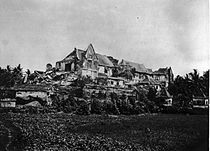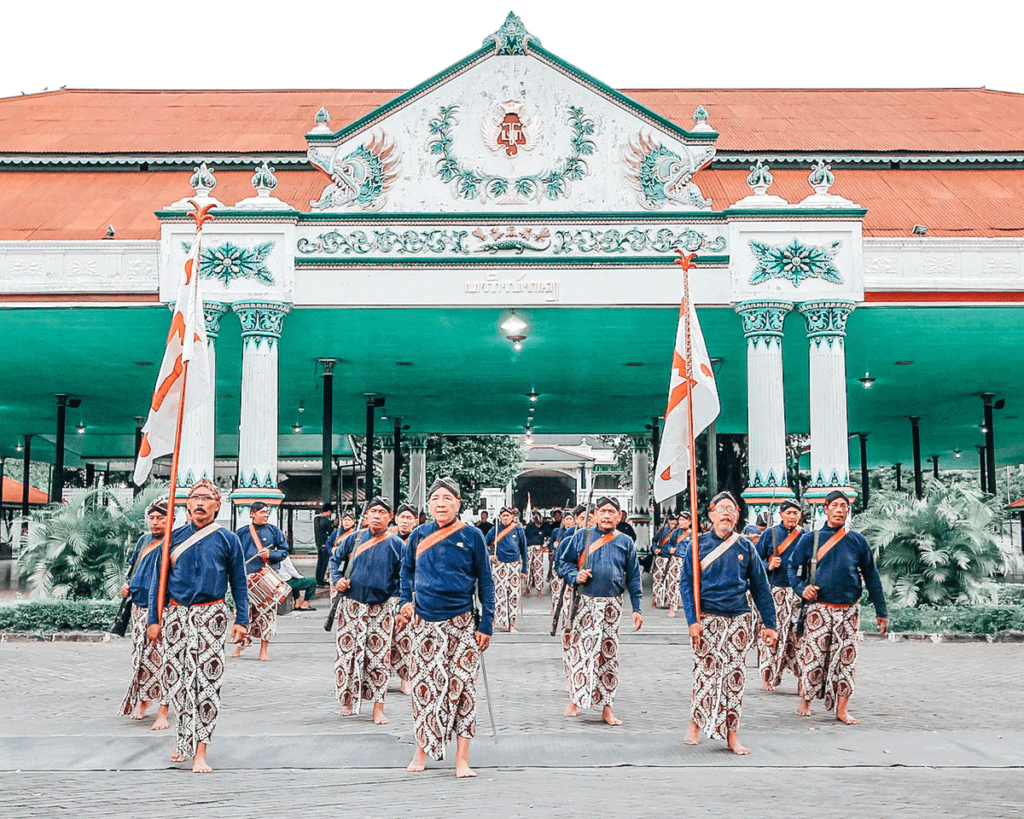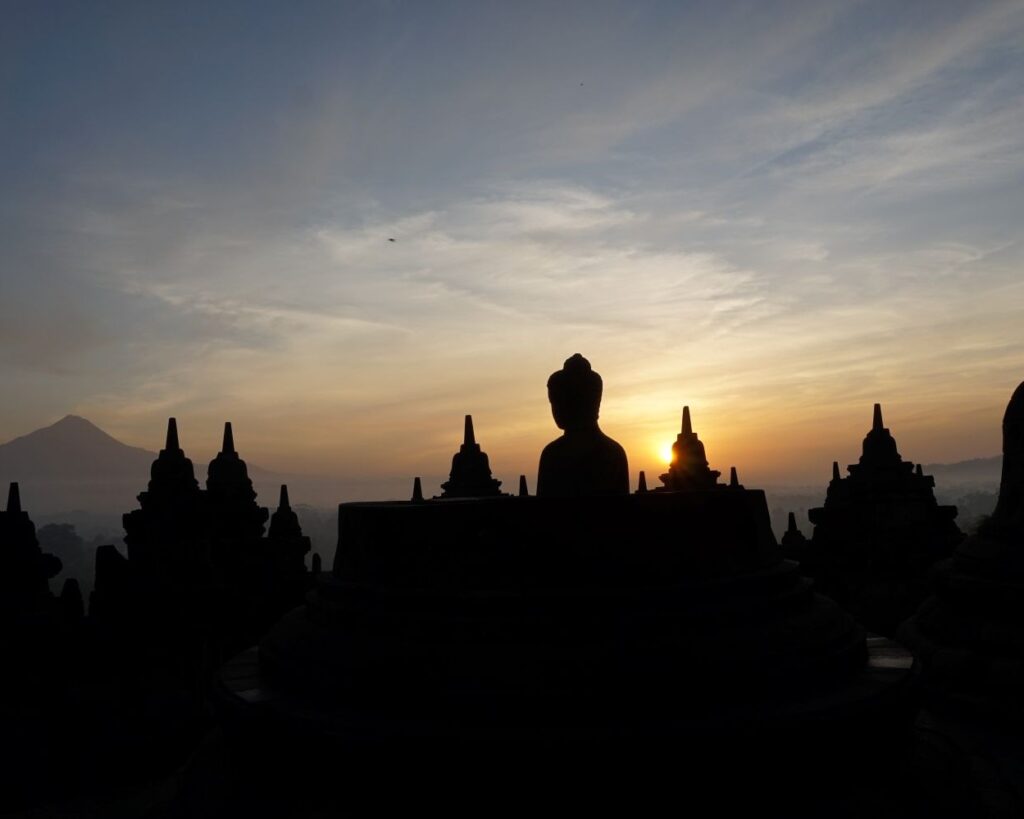Water Castle, also known as Taman Sari (Javanese: ꦠꦩꦤ꧀ ꦱꦫꦶ), is the site of a former royal garden of the Sultanate of Yogyakarta. It is located about 2 km south within the grounds of the Kraton, Yogyakarta, Indonesia. Built in the mid-18th century, the Taman Sari had multiple functions, such as a resting area, a workshop, a meditation area, a defense area, and a hiding place.
Taman Sari consisted of four distinct areas: a large artificial lake with islands and pavilions located in the west, a bathing complex in the center, a complex of pavilions and pools in the south, and a smaller lake in the east. Today only the central bathing complex is well preserved, while the other areas have been largely occupied by the Kampung Taman settlement.
Since 2017, the Historical City Centre of Yogyakarta including Taman Sari has been listed as a tentative World Heritage Site.
The name Taman Sari comes from the Javanese words taman, meaning a ‘garden’ or ‘park’ and sari, which means ‘beautiful’ or ‘flowers’. Hence, the name Taman Sari means an area of a beautiful garden adorned with flowers. An old article described it as a “water castle” (Dutch: waterkasteel); as by shutting the watergates, the complex would be completely immersed in water, leaving tall structures standing out
The building of Taman Sari commenced during the reign of Sultan Hamengkubuwono I (1755–1792), the first sultan of the Yogyakarta Sultanate, and was completed by the time of Sultan Hamengkubuwono II. The building site, however, had already been known as a bathing place called Pacethokan Spring since Sunan Amangkurat IV’s reign (1719–1726). According to Kitab Mamana in Yogyakarta Kraton, the project leader for the construction of Taman Sari was Tumenggung Mangundipura. He had travelled twice to Batavia to learn about European architecture, which is the reason why the architecture of Taman Sari has marks of European style. Taman Sari was built three years after the Giyanti Agreement as a resting place for Sultan Hamengkubuwono I. The complex consists of about 59 buildings including a mosque, meditation chambers, swimming pools, and a series of 18 water gardens and pavilions surrounded by artificial lakes. The complex was effectively used between 1765 and 1812.
The Regent of Madiun, Raden Rangga Prawirasentika, participated in funding the construction of Taman Sari. Prawirasentika also beseeched the Sultan to be relieved of Madiun’s tax obligation. He offered other alternative ways of payment. The Sultan accepted his proposal. In 1758, the Sultan commanded the Regent to supervise the making of bricks and various complements, which would be used to build a beautiful garden. The sultan wanted a place where he could spend some time to relax after many years of wars that he had just experienced. Raden Tumenggung Mangundipura, under supervision of Raden Arya Natakusuma (who later became Sri Pakualam II), was responsible for the construction. The building was started in 1684 Javanese year (1758 AD). After finding out how large the complex was, Raden Rangga Prawirasentika realized that the cost would have been greater than the taxes. He resigned from the project and was replaced by Prince Natakusuma who continued the project to completion.
The British invasion of the Yogyakarta Kraton saw considerable parts of the complex destroyed in 1812.
The building of Taman Sari ended upon the completion of the gates and the walls. A sengkalan memet (a Javanese chronogram) on the western gate (Gedhong Gapura Hageng) marks the year with the Javanese words Lajering Kembang Sinesep Peksi, denoting the Javanese year of 1691 or about 1765: lajering, ‘core’ for 1; kembang, ‘flower’ for 9; sinerep, ‘suck’ or ‘drink’ for 6; peksi, ‘bird’ for 1; the sentence can be read as “birds gathering nectar of the flower”. The relief around this sengkalan memet shows birds siphoning honey from flowery trees.
The maintenance of Taman Sari was abandoned shortly after Hamengkubuwono I died, partly because the elaborate hydraulic works were so difficult to maintain. The gardens were neglected and the buildings suffered some damage during the Java War of 1825–1830.
The palace complex fell out of use following an earthquake in 1867, which destroyed several buildings and drained the water features. Over time, squatters began to inhabit the site, surrounding the ruins of the deserted pavilions and filling the empty lakebeds.
In early 1970s, effort at restoration was made. Only the bathing complex has been completely restored.
The manuscript of Serat Rerenggan mentions the story of Demang Tegis, a Portuguese man said to be one of the architect of Taman Sari. According to the manuscript, a strange man suddenly appeared in Mancingan Village (a locality name on the south coast of Java near Parangtritis). With long nose, white complexion, and a foreign language, the villagers suspected that the person was some kind of spirit or forest fairy. They presented him to the current sultan, Hamengkubuwono II. Apparently the sultan found interest in the person and took the strange man as his servant. Some years had passed and the man had finally learned to talk in Javanese. According to him, he was Portuguese (or in Javanese, Portegis) who was stranded from a shipwreck. He also claimed to have been a housebuilder, so the sultan ordered him to erect a fortress. Satisfied by the man’s work, the sultan gave him the title demang. From then on that person was known as Demang Portegis or Demang Tegis.
There is a controversy whether Demang Tegis was actually the architect of Taman Sari, as the design resembles a hybrid of Javanese and Dutch styles, rather than Portuguese. P.J. Veth, in Java – Book III, page 631 wrote, “Local research says that [Taman Sari’s architecture] was designed by either a Spanish or Portuguese engineer, who was stranded off his sunken ship at the southern beach. However, [the architecture] that strongly shows Javanese character contradicts this.” The evidence about Demang Tegis remains an inconclusive, yet the architecture of Taman Sari moved a number of Portuguese experts on architecture and cultural heritage to examine the Taman Sari in 2001.
The widespread assumption of European influence in the design of Taman Sari has been also challenged by the research of Hélène Njoto-Feillard from the University of Pantheon-Sorbonne, presented in a 2003 conference paper. Analyzing the historic context and architectural style of the complex, the conclusion is that the creators are most likely local Javanese. The absence of any mention of European involvement in the construction of Taman Sari in Dutch historic descriptions is presented as further evidence in support of this hypothesis.
Taman Sari can be divided into four areas. The first area is the artificial lake Segaran located in the west. The second area is a bathing complex in the south of the Segaran lake, called the Umbul Binangun bathing complex. The third area, now completely gone, is the Pasarean Ledok Sari and Garjitawati Pool, located in the south of the bathing complex. The fourth area is the east side of the first and second area, which extend far to the east and to the southeast complex of Magangan.
The Segaran lake area was the main complex of the Taman Sari during its era. This complex consisted of a human-made lake called Segaran (‘artificial sea’) with some buildings located on artificial islands in the middle of a lake. The buildings are connected by an underwater tunnel. It was used as the starting point for the royal family to reach the Taman Sari pools via a vessel. Today, the Segaran lake cannot be seen any longer as the water had been drained and the lake bed is now filled with human settlements. The underwater tunnel, which is now underground after the water had gone, still exists and can be accessed.
In the middle of Segaran was an artificial island known as Kenongo Island (Javanese: Pulo Kenongo). It was named after the cananga trees which once covered the island. On this island is a one-storeyed structure called the Kenongo building (Javanese: Gedhong Kenongo), now in ruins.
On the south side of Kenongo Island is a row of small buildings called the Tajug. These buildings were originally used as air vents for the tunnel located below the lake. This tunnel, constructed in 1761, was an alternative way to reach the Kenongo Island other than by a vessel. Also on the south side of the Kenongo Island is another artificial island called Cemethi Island (Javanese: Pulo Cemethi) or Panembung Island (Javanese: Pulo Panembung). It is a one-storeyed structure for the Sultan to meditate, or some said, a hiding place for the royal family during an attack. Another name for this island is Sumur Gumantung, because on the south side of this island is a well that hangs above the ground. This place could only be reached via the underwater tunnel. The building of Cemethi Island is now also in ruin. A legend says that there is a secret tunnel that connects the palace with the south sea (Indian Ocean) where Nyai Roro Kidul or the Queen of the South has her palace. The supernatural Queen becomes the spiritual wife of Yogyakarta Sultan for many generations.
On the west side of Kenongo Island is another one-storeyed circular structure that forms another artificial island in the past called Gumuling Well (Sumur Gumuling). These one-storeyed building can only be entered via the underwater tunnel. The building was used as a mosque. A niche in the wall of this building was used as a mihrab. The central area of this building is an elevated platform where four staircases meet, and then from the platform, one staircase reach the first floor. On the ground level of this platform is a small pool that was used for Muslim ritual ablution.






